

Wars of the Three Kingdoms. The Wars included the Bishops' Wars of 1639 and 1640, the Scottish Civil War of 1644–45; the Irish Rebellion of 1641, Confederate Ireland, 1642–49 and the Cromwellian conquest of Ireland in 1649 (collectively the Eleven Years War or Irish Confederate Wars); and the First, Second and Third English Civil Wars of 1642–46, 1648–49 and 1650–51.

Although the term is not new and was already used by James Heath in his book A Brief Chronicle of all the Chief Actions so fatally Falling out in the three Kingdoms, first published in 1662,[2] recent publications' tendency to name these linked conflicts the Wars of the Three Kingdoms represents a trend by modern historians aiming to take a unified overview rather than treating some of the conflicts as mere background to the English Civil War. Some, such as Carlton, Gaunt and Royal have labelled them the British Civil Wars.[3][4][5] Background[edit] Different religious conditions pertained in each of these jurisdictions. Nine Years' War (Ireland)
The Nine Years' War (Irish: Cogadh na Naoi mBliana[1] or Cogadh Naoi mBlian[2]) or Tyrone's Rebellion[3][4] took place in Ireland from 1594 to 1603.
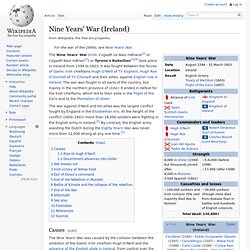
It was fought between the forces of Gaelic Irish chieftains Hugh O'Neill of Tír Eoghain, Hugh Roe O'Donnell of Tír Chonaill and their allies, against English rule in Ireland. Ulster Scots people. History[edit] Early development[edit] Royal Standard of Ireland from 1542-1801 Traditional provincial flag of Ulster.

Scottish Saltire. Plantation of Ulster. The counties of Ulster (modern boundaries) that were colonised during the plantations.
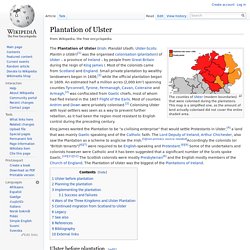
This map is a simplified one, as the amount of land actually colonised did not cover the entire shaded area. King James wanted the Plantation to be "a civilising enterprise" that would settle Protestants in Ulster,[4] a land that was mainly Gaelic-speaking and of the Catholic faith. James VI and I. James VI and I (19 June 1566 – 27 March 1625) was King of Scotland as James VI from 24 July 1567 and King of England and Ireland as James I from the union of the Scottish and English crowns on 24 March 1603 until his death.
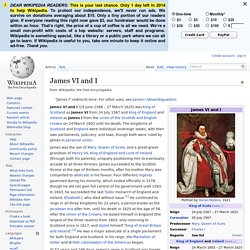
The kingdoms of Scotland and England were individual sovereign states, with their own parliaments, judiciary, and laws, though both were ruled by James in personal union. At 57 years and 246 days, James's reign in Scotland was longer than those of any of his predecessors. He achieved most of his aims in Scotland but faced great difficulties in England, including the Gunpowder Plot in 1605 and repeated conflicts with the English Parliament. Childhood[edit] Birth[edit] James was the only son of Mary, Queen of Scots, and her second husband, Henry Stuart, Lord Darnley. James's father, Darnley, was murdered on 10 February 1567 at Kirk o' Field, Edinburgh, perhaps in revenge for Rizzio's death.
Regencies[edit] James (right) depicted beside his mother Mary (left). Plantations of Ireland. Scotch-Irish American. Scotch-Irish (or Scots-Irish) Americans are American descendants of Presbyterian and other Protestant dissenters from the Irish province of Ulster who migrated to North America during the 18th and 19th centuries.[2] Most of the Scotch-Irish were descended from Scottish and English families who colonized Ireland during the Plantation of Ulster in the 17th century.[3] While an estimated 36 million Americans (12% of the total population) reported Irish ancestry in 2006, and 6 million (2% of the population) reported Scottish ancestry,[4] an additional 5.4 million (1.8% of the population) identified more specifically with Scotch-Irish ancestry.
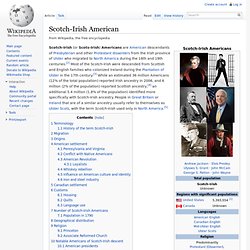
People in Great Britain or Ireland that are of a similar ancestry usually refer to themselves as Ulster Scots, with the term Scotch-Irish used only in North America.[5] Terminology[edit] The term Scotch-Irish is first known to have been used to refer to people living in Northeastern Ireland. Ulster Scots Music. Willie Drennan, writer, performer and member of the Ulster Scots Folk Orchestra and Nae Goat’s Toe was talking to CultureNorthernIreland about Ulster Scots.

What kind of music is it? What would be the ‘typical’ instruments in Ulster Scots music? 'There are different aspects of that, because as part of that you have the strong marching band tradition, pipe bands, accordion bands and flute bands, and the Lambeg and Fyffing tradition. 'You also have the folk music that would have been played in the local halls and peoples homes, and that is basically fiddle music, tin whistles, and flutes, and drums and various things like that.
And that aspect is not any different from Irish music. 'People often make this mistake that Ulster Scots music is Scottish music played in Ulster, but it’s not necessarily that. 'So, to summarize, I suppose, Ulster Scots folk music is the music that has been played by people who see themselves as being Ulster Scots. Gallowglass. The gallowglass (also spelt galloglass, gallowglas or galloglas; from Irish: gallóglaigh meaning foreign warriors) were a class of elite mercenary warriors who were principally members of the Norse-Gaelic clans of Scotland between the mid 13th century and late 16th century.
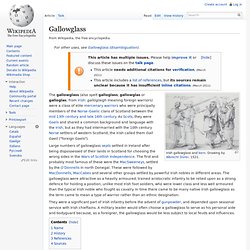
As Scots, they were Gaels and shared a common background and language with the Irish, but as they had intermarried with the 10th century Norse settlers of western Scotland, the Irish called them Gall Gaeil ("foreign Gaels"). They were a significant part of Irish infantry before the advent of gunpowder, and depended upon seasonal service with Irish chieftains. A military leader would often choose a gallowglass to serve as his personal aide and bodyguard because, as a foreigner, the gallowglass would be less subject to local feuds and influences. Border Reivers. Border Reivers were raiders along the Anglo–Scottish border from the late 13th century to the beginning of the 17th century.
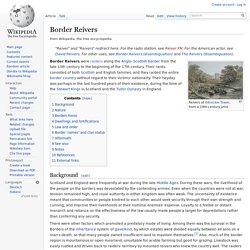
Their ranks consisted of both Scottish and English families, and they raided the entire border country without regard to their victims' nationality. Their heyday was perhaps in the last hundred years of their existence, during the time of the Stewart Kings in Scotland and the Tudor Dynasty in England. Background[edit] Scotland and England were frequently at war during the late Middle Ages. During these wars, the livelihood of the people on the borders was devastated by the contending armies. There were other factors which promoted a predatory mode of living. "Reive" is an early English word for "to rob", from the Northumbrian and Scots verb reifen from the Old English rēafian, and thus related to the archaic Standard English verb reave ("to plunder", "to rob"), and to the modern English word "ruffian".[2]